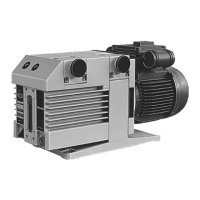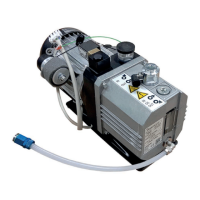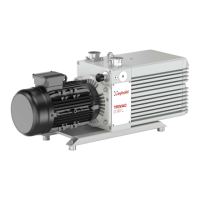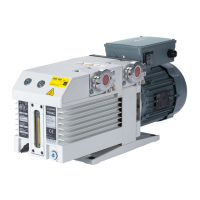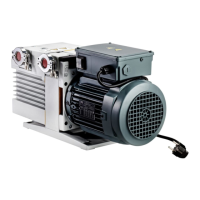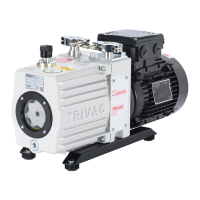3.
NOTE: Most of the vapors have been expelled from the pump when the pressure nears the "ultimate
total
pressure with gas ballast" (see Table
4-1).
NOTE:
If
your process has high levels of condensable vapors, it may
be
necessary to run the vane
pump with the gas
ballast valve open (see Section 2-3-2). When running continuously with the gas
ballast valve open,
we
recommend installing
an
SE
smoke eliminator or
an
AF
exhaust filter with
a return
line.
Close
(see Section 2-3-1) the gas ballast valve
(17)
after all vapors have been pumped out of the
system or when there
is
only a small accumulation of vapor with a large excess of permanent gases.
4-2
OPERATION
WARNING:
Don't
pump toxic, pyrophoric, or hazardous
gases
unless
your pump
has
the anti-suckback solenoid
valve
modification
(see
Pages
8 and 57).
When
pumping
these
hazardous
gases,
we
recommend a negative
pressure
exhaust system and inert
gas
purging
of
the oil
casing
and
gas
ballast valve. In addition, a pump specially prepared
for perfluoropolyether vacuum oil
is
required for pumping highly reactive
or
extremely corrosive
gas.
Contact the
factory
for
recommendations.
CAUTION: Pumping corrosive gases with a standard pump can result in premature failure. Contact the factory for
pump modifications for your particular process.
CAUTION:
RUNNING
THE
PUMP
AT
GREATER
THAN
1 TORR INLET PRESSURE RESULTS IN AN OIL
MIST IN
THE EXHAUST STREAM.
INSTALL
AN EXHAUST FILTER (SEE
SECTION
3-3) AND CHECK THE
PUMP
FLUID LEVEL FREQUENTLY (SEE SECTION 4-3-1) WHEN OPERATING
THE
PUMPABOVE
1 TORR
CAUTION:
DO
NOT RUN THE PUMP CONTINUOUSLY
AT
GREATER THAN 300 TORR INLET PRESSURE
FOR
THE
D2A,
D8A, AND D30A PUMP MODELS
OR
GREATER THAN 187 TORR FOR THE D4A, D16A, D60A, AND
D90A PUMP MODELS.
The 115/230
V,
50/60 Hz, single-phase
motors
have
an
automatically
resetting thermal overload.
If this overload shuts
off
the
pump
and the
ON/OFF
switch is left ON, the
motor
will restart itself
as
soon
as
it
cools
down.
Table
4-1
lists operating and other technical data for each of the TRIVAC dual-stage vane pump models.
1.
NOTE: The pump fluid is usually saturated with condensate when the fluid becomes milky white
or dark and the pump runs hot and
fails to reach its ultimate pressure (see Table 4-1).
REQUIRED
ACTION:
If
during
operation, the pump
fluid
becomes saturated
with
condensate,
run the
pump
with the intake tube (1)
and/or
vacuum-line valve closed and the gas ballast valve
(17)open (See Section 2-3-1)
until
the condensate is vaporized and expelled from the exhaust
port
(6).
2.
If
condensate in the pump fluid
is
severe, the pump should
be
flushed out and the pump fluid changed
(see Section 4-3-2).
See Symptom 1
of
the Troubleshooting Chart (Table 6-1) for other methods
of removing condensate from
the
pump fluid.
4-3 PREVENTATIVE MAINTENANCE
NOTE: See
Section 6 (Troubleshooting) to resolve corrective maintenance problems.
4-3-1
Checking
the
Pump
Fluid
Level
NOTE: When the pump is not running, the pump fluid level appears lower.
NOTE: It
is
not
unusual
for
the
pump
fluid to foam because of the
churning
action
of
the disk (oil slinger).
Foaming is more
pronounced
at high operating pressures. If
only
foam is visible in the oil level glass (15), it
means
that
the pump
fluid
level is low.
Occasionally check the pump fluid level when the pump is running near its ultimate pressure (see Table
4-1)
and
the gas
ballast valve (17) is closed.
The
minimum
pump
fluid
level is reached when the
fluid
surface is visible at the
lower
rim
of
the oil level glass
(15)
or
at the
"L"
mark
on
the oil
sight
gauge (72) (See Figure 1-1).
If
the
pump
fluid
level is low, use Section 4-
3-2,
Steps
7,
8,
and 9
to
add
the
appropriate
amount
of
the
correct
fluid.
The maximum pump
fluid
level is reached when the fluid surface is at the
top
rim of the
oil
level glass (15)
or
at
the"
H" mark on the oil
sight
gauge (72). If the
pump
fluid level is
too
high, use Section 4-3-2, Steps 1,3, and 5 to
drain some
fluid. Recheck the oil level while the pump is
running
to
ensure that the
fluid
level is correct.
TRIVAC "A" Manual, Edition L
11
